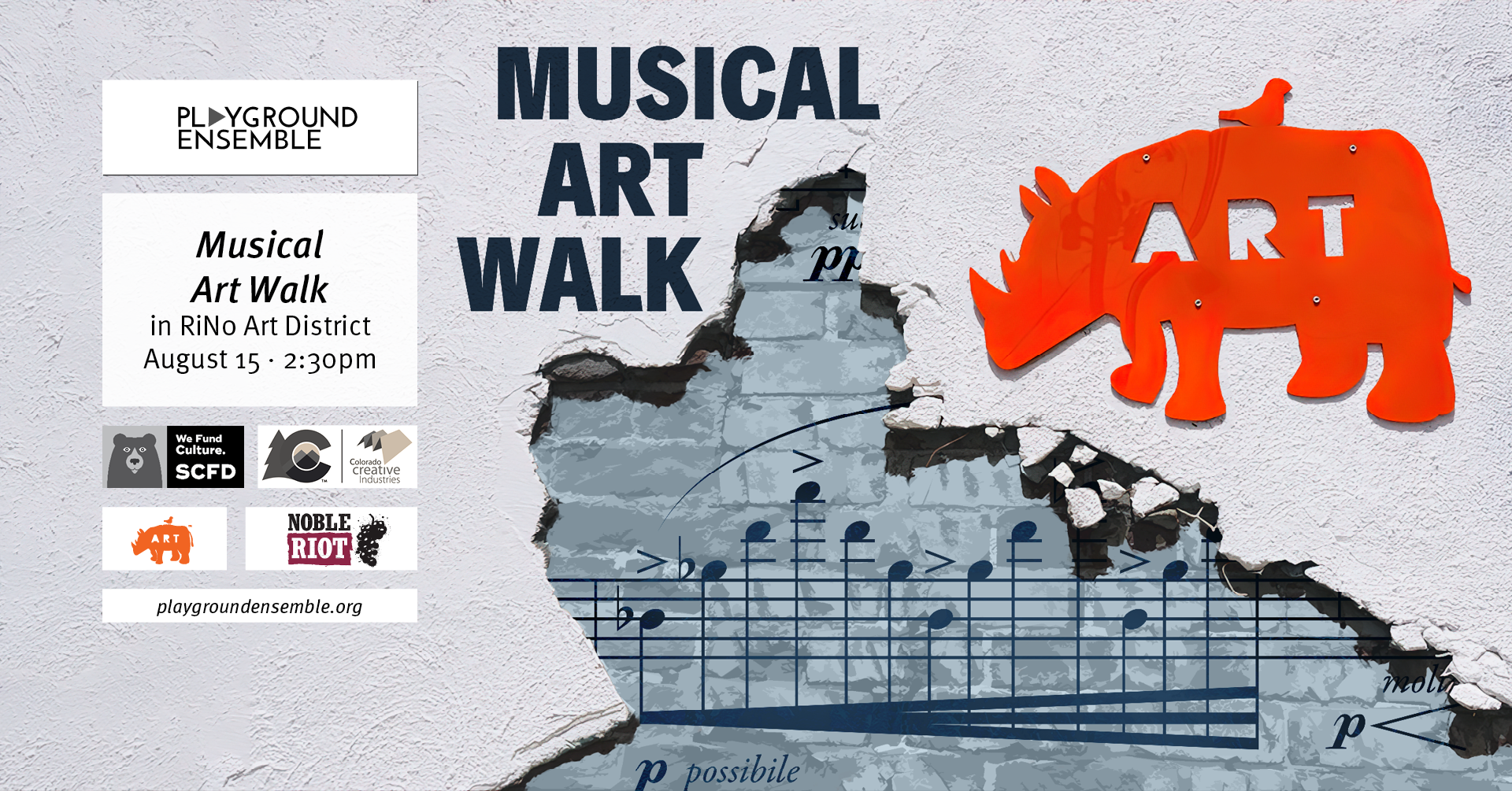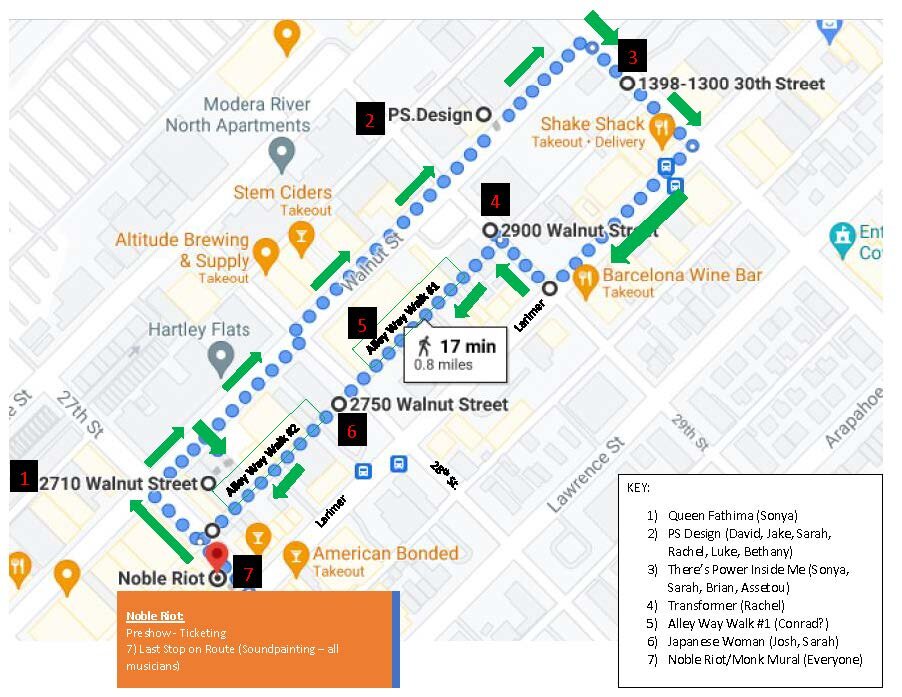August 15, 2021
RiNo Art District in Five Points
2:30pm MST
Join the Playground Ensemble for a musical walking tour of the RiNo Art District’s unique street art and murals! At each stop on this 1-mile route you’ll learn about the art and enjoy live music performed by Playground musicians. The program features a collaboration with Assetou Xango, former Poet Laureate of Aurora; a location featuring percussion made from metal plates and car parts; and a new composition inspired by COVID-19 stories by composer David Farrell in collaboration with audio engineer Jeff Merkel. Also on the program are great works by Allison Loggins-Hull, Daniel Bernard Roumain, Gene Koshinski, and Andy Akiho.
All tickets include a complimentary drink ticket to Noble Riot to enjoy at the end of the walking tour and a scavenger hunt for those of you who enjoy a little challenge!
The event is wheelchair accessible, with no seating. If you do not think you are able to stand for the entire performance, you are more than welcome to bring a camp chair or stool along for the journey.
THE PROGRAM
The Art — Queen Fathima by Jodie Herrera and Miles Toland
The Music — Homeland by Allison Loggins-Hull
Featuring Sonya Yeager-Meeks (Flute)
Inspired to write Homeland in 2017 in the aftermath of Hurricane Maria storming through Puerto Rico, Allison says of the work: “Maria represented the increasing strength of natural disasters and the intense, sometimes deadly, repercussions of climate change. While this was going on, there was also a rise of political and social turmoil in the United States, and global unrest throughout the world, including the Civil War crisis in Syria. For weeks, the news was flooded with these stories. With so many people throughout the world dealing with tragic domestic issues, I began to think about the meaning of home during a crisis. What does home mean when the land has been destroyed? What does it mean when there’s been a political disaster, or a human disaster? How does a person feel patriotic when they feel unwelcomed at the same time? Homeland is a musical interpretation and exploration of those questions. The flute opens with timbral trills representing troubled waters, then transitions into passages that are anxious and distorted. There is a moment of hope and optimism, a remembrance of past struggles that have been overcome, followed by an off-putting play on the Star-Spangled Banner, representing an unraveling of patriotism. In the end we come full circle, still with unanswered and unresolved questions.”
The Art — Meet Us Where You Are by PS.Design
The Music — where we are by David Farrell (commissioned world premiere)
where we are was commissioned to be performed in front of the PS Design building in Denver as a part of The Playground Ensemble’s 2021 Art Walk concert. The work takes inspiration from the graphic art on the outside of the building, as well as PS.Design’s Meet Us Where You Are project. In Meet Us Where You Are, PS.Design solicited written responses to the COVID-19 pandemic; the text of these submissions was shared on their website.
where we are adapts fragments of those texts. Text recordings are manipulated with hand-built electronic instruments (created with help from PS.Design’s Jeff Merkel) to create a sonic landscape that interacts with the violin and cello. The music alternates between churning energy in search of direction and unsettled stillness; both of these were feelings I experienced during the pandemic.
The Art — Resilience by Shane Huss
The Music — Hip Hop Studies and Etudes by Daniel Bernard-Roumain
Featuring Assetou Xango (Spoken Word Artist, Former Poet Laureate of Aurora), Sonya Yeager-Meeks (flute), Brian Ebert (bass clarinet), and Sarah Whitnah (violin)
“Hip-Hop Studies and Etudes, Book I are small, intimate, musical vignettes (one in each key) that explain, examine, and express aspects of hip-hop music, from rhythm to timbre to form. What began as a response, a composer’s response, to the musical and cultural needs of students at the Harlem School of the Arts in New York City (where I once served as chair of the Music Theory and Composition Department), these works now represent my own hip-hop, techno, ambient, and rock-infused response to Bach’s Well-Tempered Klavier and Philip Glass’s Music in 12 Parts.
The scores are designed to be performed by one musician to any number of small or large instrumental ensembles. If performed by one musician, simply pick the line and/or clef of music that is best for your instrument and makes for the most complete idea. If performed by a small or large instrumental ensemble, all musicians should read from the score and should assign those parts that are best for their instruments. Tempo indications are suggestions only; feel free to play these works at any speed you desire, with or without a conductor.
I welcome the re-arranging (or remixing) of any part of this music–feel free to edit, move, delete, repeat, or imagine the music in any manner that you deem fit.”
The Art — by TKO Crew
The Music — Echo Song by Gene Koshinski
Featuring Rachel Hargroder (Percussion)
Echo Song (released in 2014), a multi-percussion solo composed by Gene Koshinski, was inspired by a madrigal for antiphonal choirs of the same name by Renaissance composer Orlando di Lasso. Koshinski uses the Ritmica method, which focuses in part on the simultaneous performance of unrelated meters and ostinato patterns, or polyrhythms, as well as contradictory melodic material. There are contradictions to be found within the timbres, too, as the soloist plays bongos, 4 octobans (or in this case, 3 metal plates and 1 brake drum), kick drum, and splash cymbal. Within the selected timbres (membranic and metallic with one splash cymbal), there are seven graduated, arbitrary pitches, which initially focus on the upper pitch of the bongos with groupings of rhythms (such as 5:4 and 6:4) as well as ample improvisational opportunities for the soloist. Another set of bongos and kick drum comprise the echo part, which can be played by an assistant player in the distance, or the soloist. The result is an engaging work that also allows for some performer discretion as to the length of repeats.
The Art — HANA by Casey Kawaguchi
The Music — Hammers by Andy Akiho
Featuring Sarah Whitnah (Violin), and Josh Sawicki (Toy Piano and Percussion)
Hammers was originally an interlude between the second and third movements of Akiho’s Percussion Concerto (premiered in 2019). Now published as a short stand-alone piece, Hammers is a duet between toy piano and violin, characterized by playful cross-rhythms and heavy use of pizzicato in the violin. The piece skillfully uses the limited range of the toy piano and drafts the pianist as a percussionist as well.
The Art — The Monk by Detour
The Music — Soundpainting
Featuring Everyone
Soundpainting is a hand gesture-based composition language for musicians, artists, dancers, and actors. In a session, Playground artists will perform and demonstrate the gestures and by the end of the session, audiences are leading the ensemble in a performance. This is one of the Playground’s key educational offerings and works as an all-school assembly, a classroom visit, or as a multi-visit residency.


